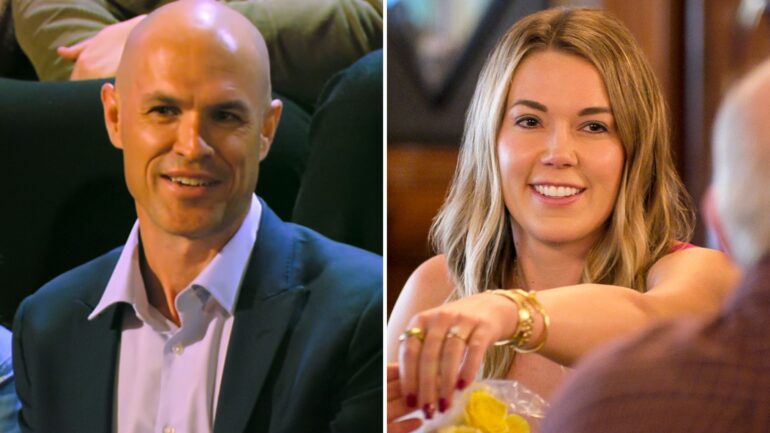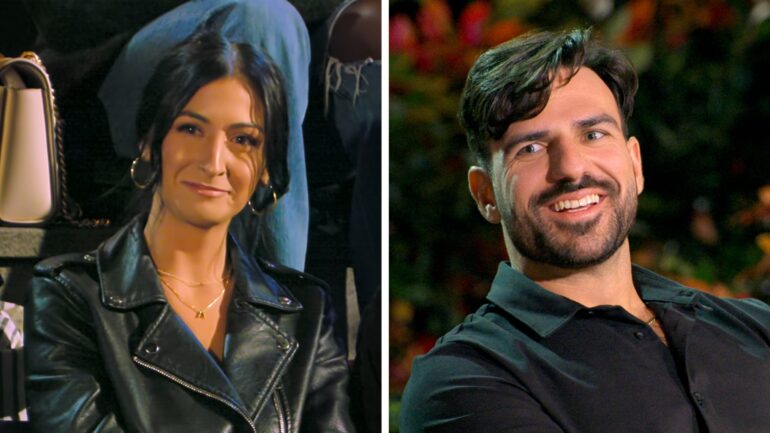Exclusive Interview
Marissa Meyer Talks Romance in ‘The House Saphir’ Bluebeard Retelling & Sequel Plans

What To Know
- Marissa Meyer’s new novel, The House Saphir, is a Bluebeard-inspired continuation set 100 years after the original tale.
- Meyer spoke with Swooon about drawing on her lifelong fascination with fairy tales, exploring feminist themes and evolving story traditions, and more.
- The House Saphir is planned as the first in a trilogy, with each book focusing on a different fairy tale and couple.
The queen of fairy tale retellings is back! Marissa Meyer, who rose to fame in the YA world with The Lunar Chronicles, has put her spin on yet another classic story with The House Saphir.
Describing her new romantasy as a “continuation” of a centuries-old folktale, Meyer explained the twisted story of Bluebeard to Swooon. “It’s about a girl that marries a very wealthy merchant, only to discover that he is a serial killer who has murdered all of his previous wives. And, of course, it’s looking like she’s going to be the next victim until her brothers swoop in and rescue her at the last moment, and they end up killing Bluebeard at the end of the story. And so I started to think, what if that had happened?”
The House Saphir takes place 100 years after the murders have passed, following complicated heroine Mallory. She gives unsanctioned tours of Bluebeard’s abandoned house, helped along by her ability to see and communicate with ghosts. It’s during one of those tours that Mallory finds out that Bluebeard’s murderous ghost has returned, and his great-great-grandson needs her help to get rid of him.
Armand, the descendant, thinks that Mallory has powers that will help him solve the problem. Only only issue is that, despite hailing from a line of witches, Mallory doesn’t have any magic of her own. Still, seeing the opportunity to make some cash, she decides to take Armand up on his offer. Sprinkle in a slow burn romance, a few scares, and a dose of humor, and you’ve got The House Saphir. Swooon sat down with the author to break down her latest book and what’s coming next for the series.
Let’s start off by just talking a little bit about the inspiration behind The House Saphir and how long it’s been in the works.
Marissa Meyer: The book is very much inspired by the fairy tale of Bluebeard. As far as how long it’s been in the works, that has some mixed answers because, on one hand, Bluebeard was a fairy tale that I discovered when I was five or six years old. It was in a little book of fairy tales that my grandma gave me. It was so dark and so creepy and so unlike any of the other fairy tales that I knew of, that it very much kind of latched on. On one hand, I thought it was really bizarre and scary, but on the other hand, bizarre and scary things are fascinating. Just as a kid, I was like, this is a cool story, so it’s just one of those stories that has been in the back of my head pretty much my whole life.
I knew that I wanted to do a retelling of Bluebeard as early as maybe 10 years ago when I was still working on The Lunar Chronicles and starting to think what’s going to be after this, what’s going to come next? And I’ve had lots of different ideas for how I might retell this story, but nothing was ever quite right. I would toy around with some ideas and then put it aside and move on to something else. But I always have kept coming back to Bluebeard, knowing someday I want to do something with this story. I’m going to say maybe about two years ago is when the idea of The House Saphir really started to kind of cement in my brain. I had the idea, instead of doing a direct retelling of the story of Bluebeard, I would love to do more like a continuation. What if the fairy tale happened?
How has your approach to retellings changed over the years, and what keeps you coming back to these kinds of stories?
Meyer: It really depends on the story. So, of course, in The Lunar Chronicles, they were very direct retellings. Gilded and Curse were a fairly direct retelling of Rumpelstiltskin, although I made lots of changes. Heartless was more of a prequel to Alice in Wonderland. So it really just depends on where I want to take the story and what’s inspiring me.
But as far as what keeps bringing me back to them, I really just love fairy tales, and they have been such a big part of my life, such a big influence on me since I was a little girl. I’m fascinated by how these stories, on one hand, they are everywhere in our culture. You can’t get away from them. We all have memories of being read these stories as a child. We all have connections to Disney movies. They’re just so present. But I am particularly interested in seeing how the stories do change and evolve for new generations, for new societies as the rise of feminism has grown. What has that done to these stories? Or just various ways that society changes, and then you see it reflected in the tales. I really love comparing what stays the same, and then you can see what those very universal notes are that really seem to be timeless versus what does change. For me, being a writer and a storyteller, it’s fun to be able to give my own interpretation.
I see the feminist spin on this one for sure.
Meyer: You know, it’s so interesting because in all these fairy tales, there’s different versions of these stories. The story of Bluebeard tends to be the most popular one, the one that Charles Perrault wrote down, and that’s the one in which the heroine is rescued by her brothers. But if you start digging into it and reading, there are other versions of this story in which the heroine saves herself. And so I’m always really fascinated by why that one doesn’t get told. I always want to kind of draw from those inspirations, too.
Because we’re Swooon, I have to ask about Mallory and Armand’s dynamic. Beyond their magical fates bringing them together, what draws them to each other? In what ways do they balance each other out?
Meyer: It was really fun for me to write them because you’ve got Mallory, who is not a “lady.” She is fascinated by weird, dark, morose things. I think that this is so relatable, especially in this day and age, with the rise of true crime. Who doesn’t have this kind of morbid curiosity about these things? And Mallory, with this being somewhat historical fantasy, this is a society in which women are not supposed to talk about these things, and you’re not supposed to be curious about these things, but she, for the most part, doesn’t really care. She’s really comfortable being who she is and has found ways to profit from these inclinations of hers. On the flip side, you have Armand, who has been raised a Count. He has been raised to have a certain level of respect. And yet, he also recognizes that this horrible, dark thing happened in his family’s past. He is also curious about it. He’s interested in weird things, but it feels like, because of his role, he’s not allowed to explore them.
And then he comes across this girl who has no problem whatsoever talking about blood and guts and gore. She really catches him off guard, but then he also finds that really intriguing and very refreshing. That was kind of the angle that I was working with the most when I was developing their dynamic, and what it is about her that is most enchanting to him.
For Mallory, she’s never really believed in love, or she didn’t ever make it a priority in her life. What about Armand is different? How does he get through to her?
Meyer: That’s a great question because definitely one of the biggest themes of the book is trust. We really establish from the beginning that Mallory has trust issues. She barely trusts herself. Her sister is the only person in the world that she feels like she can rely on. And having this obsession with murder, she’s very aware that most of the murders that she has read about and studied are men killing women. And a lot of times they are romantic interests, killing their wives, killing their mistresses, these sorts of things. She’s pretty much just like, nope, not going to happen. I would never fall for that.
And yet, as she gets to know Armand, she just can’t help being drawn to him. He seems like a very stable presence. There’s things about him that she just finds so attractive, so calming and soothing for a girl who has never really felt calmed and soothed before. At the same time, as bad things are happening in the story and in this house, she can’t help but wonder, does he take after this ancestor? Does he himself have some murderous tendencies? And so I really wanted to play with this idea that she is falling for him at the same time that her suspicions are growing, and she can’t help wondering, is he actually a murderer?
[Warning: The below contains spoilers for The House Saphir’s ending.]
Do you see yourself continuing Mallory and Armand’s story or continuing in this world in general?
Meyer:The House Saphir can very much be read as a standalone novel, but it is also, in a way, the first of a trilogy in that every book in the trilogy is going to focus on a different fairy tale and on a different couple. So in this book, we meet Mallory’s sister, Anaïs, and then we also meet a couple of traveling curse breakers-slash-monster hunters. They go by Fitcher’s Troupe. At the end, Anaïs joins Fitcher’s Troupe, and they go off on the next adventure, so the next book is going to be following Anaïs and her story, and that’s going to be a retelling of Puss in Boots.
Can you tease anything about her future love interest?
Meyer: It’s somebody that you’ve met, and I think a lot of readers will pick it up [in The House Saphir]. The hints are there, for sure.
Will we still see Mallory and Armand in some capacity?
Meyer: To be determined, for the second book. Because they’ve gone on to a different country at this point, there might be letters coming in from Mallory, but I don’t see them playing a big role. When we get into book three, that’s a really big question mark at this point.
I guess we can trust that they’ll be happy together somewhere.
Meyer: Absolutely. They’re destined for true love, happily ever after. I feel that way about all of my couples.
What do you hope readers take away from the series?
Meyer: My goal tends to pretty much be the same for every book that I write. It hasn’t changed much over the years. I want to tell a great story, and I want people to feel like they have been swept away. I want readers to swoon, and I want readers to feel their hearts speeding up when things are getting scary and death is approaching. I also want them to laugh and feel like they’re just having a really enjoyable time. So my hope is it’s the sort of book that will last with people, maybe that they’ll pick it up again and again.






